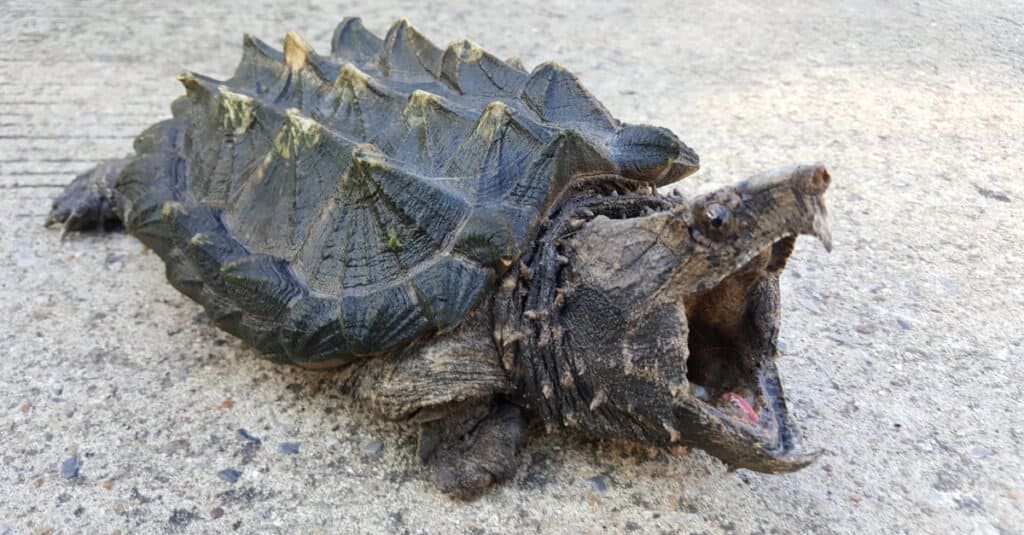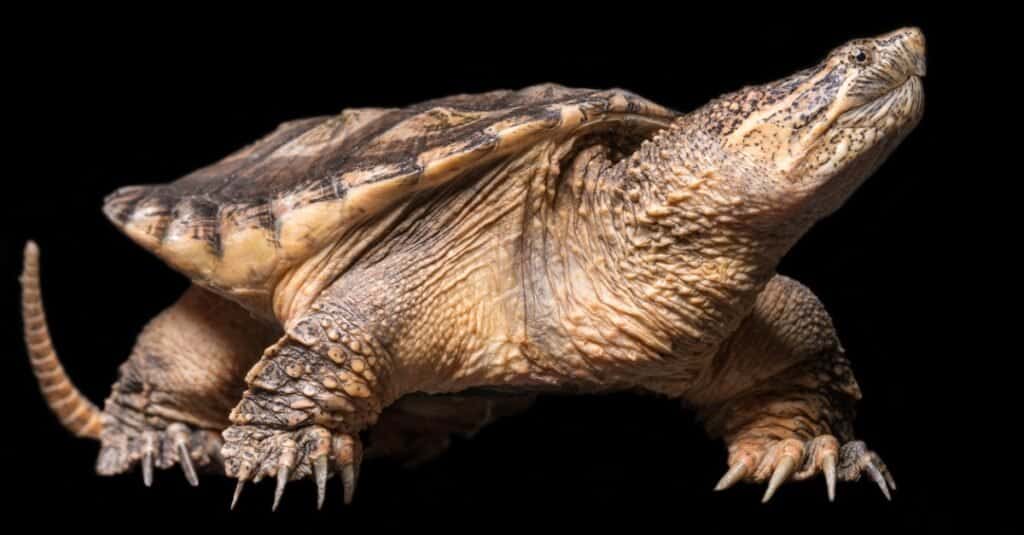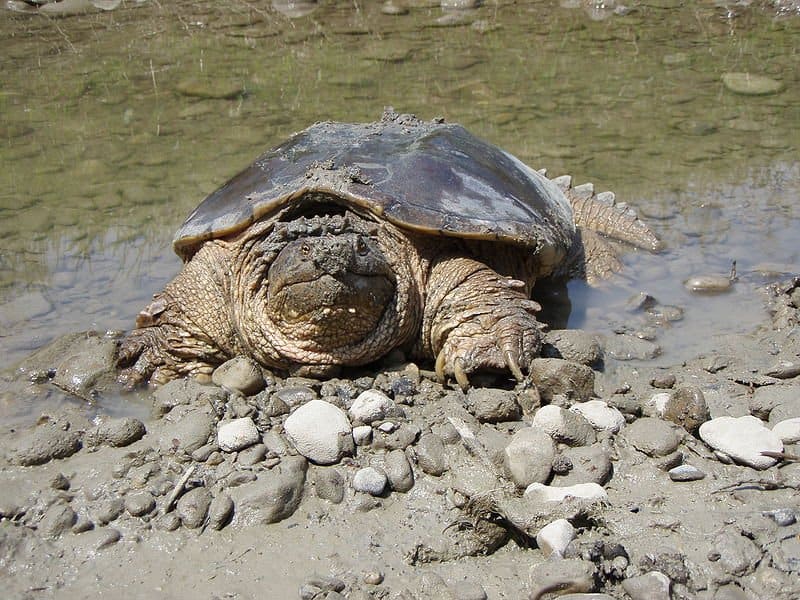Snapping turtles are the largest freshwater turtle in North America, and they’re also one of the most common. In fact, snapping turtles have been around for over 70 million years! They can grow up to two feet long and weigh as much as 35 pounds. These turtles can live 100+ years in captivity! But just how old can snapping turtles get? We’re diving into just how old the oldest snapping turtle ever was!
Background on Snapping Turtles

Snapping turtles can weigh as much as 35 pounds!
©Tyler Clemons/Shutterstock.com
Snapping turtles are found throughout eastern Canada and all along the East Coast of the United States. They live in streams, rivers, ponds, lakes, and marshes with slow-moving water that is easily accessible on land or through mud flats. Their diet consists primarily of fish but will also include frogs, newts, crayfish and other aquatic invertebrates when available.
Snapping turtles have a very interesting way of hunting their prey: they wait patiently for fish or other small animals to come close enough to snap at them with their powerful jaws. The snapper’s strong, hooked beak allows it to hold onto large prey underwater until it drowns. Snappers use their long tails as a rudder while swimming–and sometimes even as an anchor when waiting near the bottom for food to swim by.
Snapping turtle appearance varies from different areas where they live. But most snapping turtles have a large head with a ridged back shell that allows them to hide from predators by sliding into water making it hard for their enemy to catch them. The snapping turtle has a square-shaped end on its tail that helps it swim faster in water and walk better on land. The average male snapper’s carapace is about 16 inches long whereas female carapaces will be about 18-22 inches long when fully grown. The shell coloration ranges from dark brown to black with light areas on the ridges.
There are two species commonly called “snapping turtles” in the United States. The common snapping turtle and the alligator snapping turtle. While they’re not closely related to one another, we’ll examine both today since they’re both frequently called “snapping turtles.”
Snapping Turtles are More Common Than You Think
There is an estimated 6-12 million snapping turtles in the U.S. alone! They are among the most common turtles found in North America. Snapping turtles (Chelydra serpentina) can be found anywhere where there is water, but prefer bodies of slow-moving water with soft mud bottoms and abundant aquatic vegetation. Also, they like to bask on logs or rocks near water’s edge.
The Lifecycle of Snapping Turtles

An alligator snapping turtle
©Sista Vongjintanaruks/Shutterstock.com
The lifecycle cycle of a snapping turtle is quite interesting. Depending on the species they can reach sexual maturity anywhere from 4 to 21 years of age. For example, while male common snapping turtles can reach maturity at 4-5 years of age, female alligator snapping turtles reach maturity at 13-21 years old.
Snapping turtle nests are typically laid in a sunny location on land near a body of water. The eggs incubate for around two months, and after hatching, the baby turtles will make their way into the water.
Humans and Snapping Turtles
People used to hunt snapping turtles for their meat, but now most people harvest them for their shells. Snapping turtle shells are valuable because they are strong and durable. They are often used to make products such as eyeglass frames, cell phone cases, and jewelry. Some people also keep snapping turtles as pets. Snapping turtles can be very tame and friendly when they are used to people. They make interesting and amusing pets for those who have the patience to care for them.
Many people who eat snapping turtle soup believe that it is good luck to do so on New Year’s Day and on certain other days during Chinese New Year celebrations such as “The Feast of the Hungry Ghosts.”
Snapping Turtle Lifespan
Snapping turtles have a lifespan that ranges from 25-35 years. Females can live up to 50 years. Turtles in the wild usually don’t live past 35 because of predators, disease and lack of food. In captivity, they can live 100+ years.
The World’s Oldest Snapping Turtle

A snapping turtle isolated on a black background
©iStock.com/looderoo
The oldest snapping turtle ever recorded was an alligator snapping turtle named Thunder that was estimated to be 150 years old when it passed away in 2016.
Thunder lived at the Newport Aquarium, near Cincinnati. Her age was estimated after she was found near a seafood market in Louisiana in the early 1990s. Analysis of other snapping turtle species indicates an ability to live to extremely old age as well. Scientists have estimated captive common snapping turtles could live past 100 years of age in captivity, so it is likely many snapping turtles have exceeded the age of all but the oldest humans.
How do Snapping Turtles Compare to Sea Turtles and other Tortoises?
Sea turtles and other tortoises are not as common as snapping turtles, and they are not as adaptable to different environments. Snapping turtles can live in a variety of habitats, from cold freshwater to brackish water to estuaries. They can also tolerate a wide range of temperatures. Tortoises also live in warmer climates than snapping turtles.
Snapping Turtles: A Conservation Concern?
Snapping turtles have been around for over 70 million years and they are one of the most common turtle species in North America, but they are becoming increasingly rare. Snapping turtles are a conservation concern because they are being hunted for their meat and their eggs are being harvested from nests.
How Can We Help Snapping Turtles?

A snapping turtle emerging from the water
©Ontley – Public Domain
There are many things you can do to help protect snapping turtles:
- Don’t harvest their eggs from nests.
- Don’t hunt them for their meat.
- Don’t buy products that contain snapping turtle meat or eggs.
- If you see someone hunting or harvesting snapping turtles, report it to the authorities.
- If you have a pond or other water body on your property, provide a basking area for snapping turtles.
- Educate others about the importance of snapping turtles.
- Help with research on snapping turtles and their habitat.
Snapping turtles are an important part of our ecosystems, and we need to do what we can to protect them. Thank you for helping to keep them safe!
The photo featured at the top of this post is © Sista Vongjintanaruks/Shutterstock.com
Thank you for reading! Have some feedback for us? Contact the AZ Animals editorial team.






